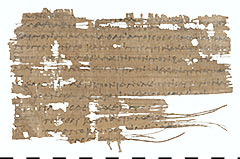P. 11793
Inconspicuous, but always good for surprises. A small papyrus fragment provides insights into literary production beyond the major centres and can score points with details that are otherwise barely documented, if at all.
The papyrus comes from mummy cartonnage acquired for the Berlin Papyrus Collection by Friedrich Zucker in 1910 in Mallawi in Middle Egypt. This means that the papyrus was no longer needed at some point in antiquity and was therefore processed as filling material in mummy cardboard. The papyrus could then be removed from this mummy cartonnage. Many damages derive from this processing.
The twelve preserved lines were written in a broad and regular cursive typical of the early 3rd century BC. Since the writing extends almost to the edge of the papyrus on the right and left, the original line length is clear and can be determined with certainty for the lines that have not been completely preserved. The width of the margins, on the other hand, must remain uncertain, as it may also have resulted from the trimming of the papyrus during its processing into mummy cartonnage. Traces of ten lines of another text are preserved on the reverse side.
The papyrus contains the beginning of a hymn to the goddess Demeter. Demeter is one of the twelve Olympian gods of Greek mythology. She is responsible for the fertility of the earth, the seeds and the grain, which is why she was often depicted with an ear of wheat or flowers and fruit. Her most important place of worship was in Eleusis, northwest of Athens, where the Eleusinian Mysteries were held annually in her honour. Demeter is the sister of Zeus, Poseidon, Hades, Hera and Hestia. With Zeus she has the daughter Persephone, who was abducted by Hades into the underworld. Since Demeter, grieving over this loss, let the animal and plant world die off, the other gods forced Hades to release Persephone, who was now allowed to spend part of each year with her mother on earth, but lived the rest of the time in the underworld.
Of the hymn itself, only the introduction has survived, in which the goddess Demeter is invoked and then a prequel tells how the world was divided up between the gods by lot. Poseidon got the sea, Zeus the sky and Hades the underworld. Although the text breaks off here, it can be assumed that in the part of the hymn that no longer exists, the famous robbery of Persephone by Hades and the search by her mother Demeter were sung.
The composition, which is presented here in a partly faulty private copy, is the work of an amateur with many echoes of Alexandrian poetry and especially its most famous representative Kallimachos. They are evident, for example, in the use of the name Agesilas for Hades, as it also appears in Kallimachos, but is otherwise very rare and rather attested as an epithet of Hades. Equally striking are the new creation of a word for which a very similar word creation can be found as a model in Kallimachos‘ Hymn to Demeter, and the designation of the priestesses of Demeter as bees.
Most interesting, however, is the verse metre, which is otherwise only known from Horace’s Latin poetry. In Greek literature it is only found in this hymn. It is a verse couplet (distichon) called archilochium primum, which consists of a hexameter and a dactylic tetrameter, the two parts of which, however, are not visible on this papyrus through a line change. The verse pairs are separated by a short line at the beginning of the line. This verse metre was named after the Greek poet Archilochos, to whom it has been attributed. However, this is uncertain. It is possible that it is an Alexandrian invention, which would confirm the dependence of this hymn on Alexandrian poetry.
All in all, this hymn impressively shows how learned Alexandrian poetry, and especially that of Kallimachos, spread. This was presumably the work of a teacher or even a scribe with literary and above all poetic ambitions.
This Hymn to Demeter was on display in the special exhibition „Soundscapes – Music in Ancient Egypt“.



